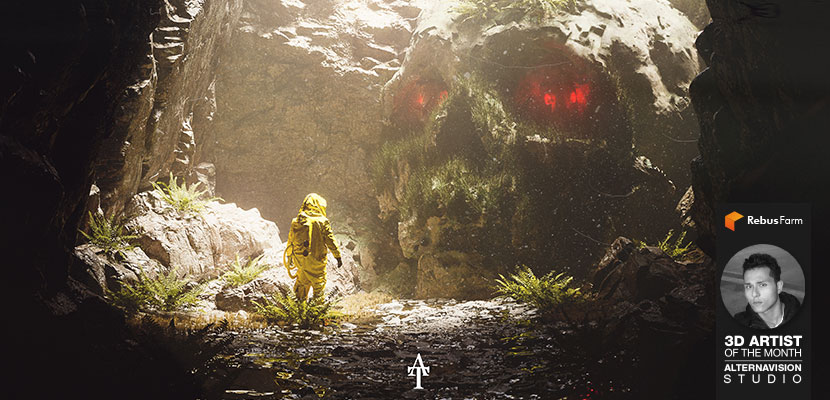
When young Abderrahman Alterkawi, our Rebus render farm September 2023 3D Artist of the Month, first opened Blender, he had no idea of how much his future was about to change with a single click. A few years and a lot of dedicated learning later, the up-and-coming CGI generalist is filled with entrepreneurial spirit, positioning his company AlternaVision Studio on the market and already making expansions plans.
In our interview, Abderrahman discusses his empathetic approach to client relations, the importance of personal projects, and sacrifices in the name of "l'ambiance".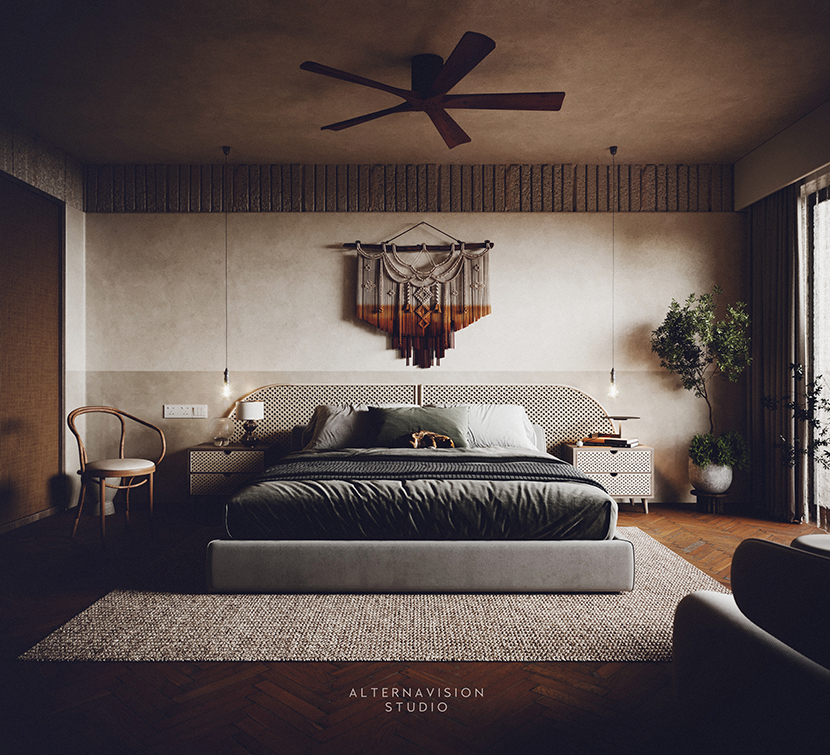 Architecture and automotives are AlternaVision's bread and butter.
Architecture and automotives are AlternaVision's bread and butter.
Hi Abderrahman, thanks for joining us! To start things off, please introduce yourself to our readers.
Hello everyone, I am Abderrahman Alterkawi, a young CGI generalist and founder of AlternaVision Studio. I am originally Syrian/Moroccan but currently reside in Marrakesh, Morocco.
Do you recall when and how you first consciously encountered CGI?
The first time I encountered CGI was around late 2016 after watching a speed level design timelapse made in Unity, which sparked my interest in both gaming and coding. In fact, I decided to get a new laptop with the sole purpose of coding simple games.
Now here's the interesting part: when I first received the laptop, I bulk downloaded a whole bunch of apps off a website, including Spotify, 7-Zip, and Blender 2.7X. I spent the next two days exploring all these apps and downloading necessary libraries to start learning to code - until I opened Blender for the first time, that is. The UI was baffling to me, it felt like something out of a submarine or a late 90s movie. Still, I was intrigued, so I eventually just pulled up Google and typed in Blender 2.7X, which led me to one of Andrew Price's videos, the rope tutorial. The thumbnail was so amazing to me that I instantly knew I wanted to create something like that.
When and why did you then decide to pursue a professional career as a 3D artist?
For the longest time, CGI was more of a hobby than a career choice for me. I was still a full-time student back then, spending most of my day studying and learning 3D in my spare time. I did my first serious project around 2018, when I was commissioned to make a textured model of a Nissan car for a guy who wanted to add it into a game for his son. It took me about a month to complete, and I was only paid the first half, but I did not even mind at the time, since I enjoyed the process so much.
By then, I had already been doing freelance web design work for multiple years, so I gradually expanded my services to include 3D. The work load was pretty frail at first, since I had no digital footprint and could only work after school. All of that changed during the lockdowns, which to me at the time meant more time to study, and more time for CGI. I started taking my work more seriously, collaborating with a professional studio and putting myself out there more. I also became a little more business savvy around that time, charging rates that corresponded to the actual work I was doing.
What training or education do you have?
Mostly YouTube and a whole lot of trial-and-error! I genuinely believe that given enough interest and time, you can learn anything and become decent at it, especially if there's a comparable number of free resources available as is the case for CGI. I think the only course I spent money on was the Blender car modeling course by CG Masters, which improved my skills tremendously.
I also started reading a lot of articles on sites such as RebusFarm, RonenBekerman, BlenderArtists, and 3dtotal, while picking and committing myself to my own projects. I obsessively researched even the smallest aspects, which taught me to find unconventional ways of overcoming limitations, and steadily progressed from using simple tools to more advanced techniques.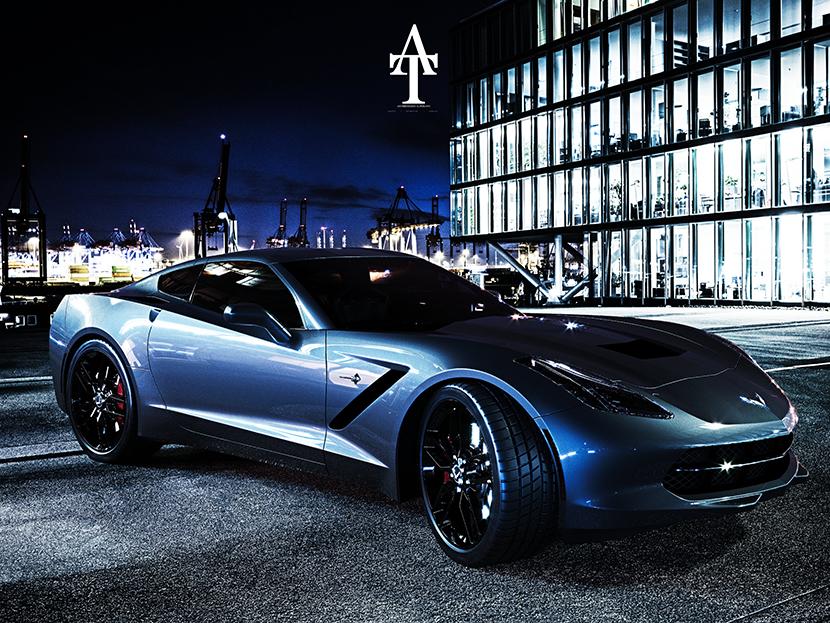 Blender fans know what's up: Abderrahman created this sleek Corvette following the CG Master's course on car modeling.
Blender fans know what's up: Abderrahman created this sleek Corvette following the CG Master's course on car modeling.
Please tell us about your brand AlternaVision Studio. When and under what circumstances was the studio established?
My studio is pretty new, at least in its current incarnation. When I first created a personal brand in 2021, I used a different logo and my actual name, which in hindsight strikes me as a little narcissistic (laughs). Earlier this year, I completely redesigned everything from the ground up, made a new website and changed the name to AlternaVision.
Outside of the occasional cooperation, my studio is a one-man jack-of-all-trades operation. Thanks to my background as a CGI generalist, I am proficient at every step of the workflow and can realize most archviz projects rather quickly. The studio was mostly a byproduct of my desire to have a personal print on my work, and to have a greater sense of achievement and responsibility.
What services do you provide and who are your clients and target markets?
I offer virtual tours, exterior rendering, concept development, interior design, product visualization, and automotive design. My client base mostly consists of architects and manufacturers, although I recently had the pleasure to work with several real estate and finance companies, which proved to be the best experience I've had thus far!
How would you describe your overarching vision as an archviz company?
My core philosophy when working with a client is to put myself in their shoes. You should always be considerate of the fact that what might be a routine job for you, could be of the utmost importance to the person requesting your service. Whether it's someone's future place of residence, or a crucial part in acquiring funding for an investor, your visuals might play a decisive part in someone else's dream project. So I always try to be kind and understanding and leave some room for uncertainty, while at the same time move things along according to schedule.
My ultimate goal with the studio is to reach a point where I can hire multiple people and realize large-scale projects from scratch, meaning not only archviz but the entire pipeline. In addition, I want to position AlternaVision as a company that is involved in automotive launching events and marketing campaigns. To accomplish this, I first need more experience working in a large studio setting, so I'm on the lookout for opportunities.
Another thing that is near and dear to me personally is to develop high-end courses and trainings tailor-made to suit your individual needs and circumstances. To make this happen, I'm working with a friend and partner in the UK; we're currently looking at all the necessary steps and paperwork while calculating the costs. In preparation for this, I already set up a dedicated YouTube channel and started working on a free project-based masterclass that will teach how to create amazing scenes within the course of two to four hours. This is not only meant as an appetizer for what's to come, but also my way of giving back to the community which has been so incredibly generous in their continued support. I am both excited and confident that what we have to offer are unique and valuable solutions!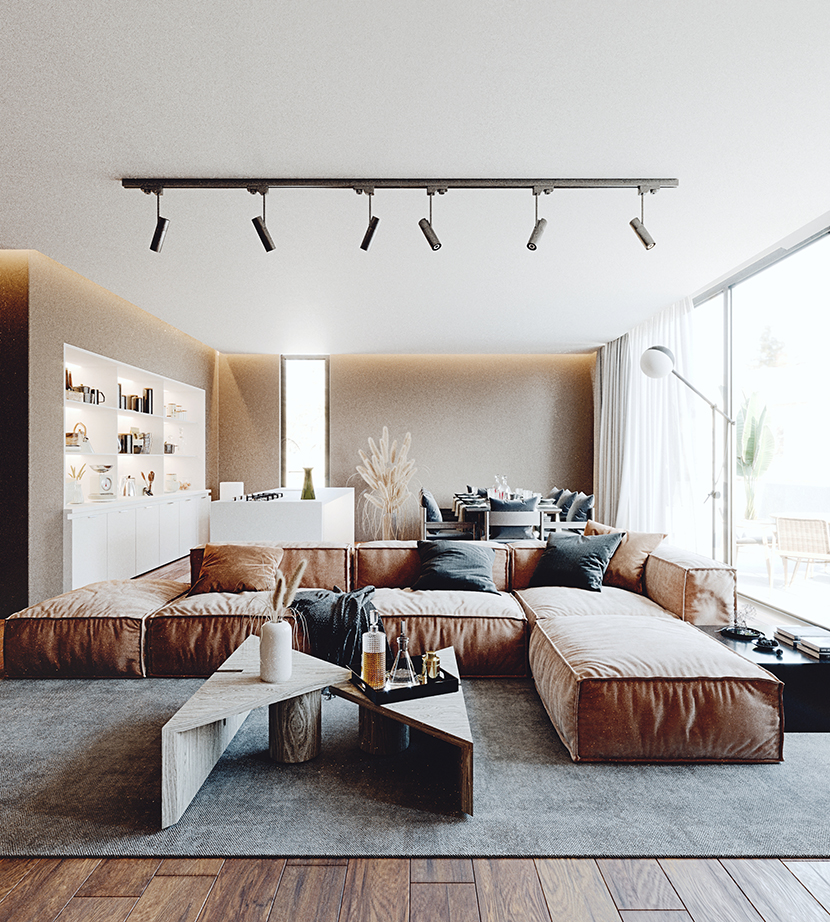 Abderrahman used this living room study to hone his skills in asset creation and lighting.
Abderrahman used this living room study to hone his skills in asset creation and lighting.
Describe your profile as a 3D artist! What are your main areas of expertise?
I like to think of myself as a generalist, someone who can do everything if needed, but also specializes in certain aspects. My main domain is architecture and environments as well as automotives, cars especially. This is how I earn my living, after all.
However, I am also very interested in character design. It's the most challenging aspect of 3D art in my opinion, as it requires such extensive knowledge, ranging from anatomy and sculpting to skin simulations, blend shapes, and grooming. I eventually stopped working on digital doubles and creatures since it got a little too overwhelming, and I wanted to focus on areas that are more important to me careerwise at the moment.
Is there a part of CG-related work you particularly enjoy? For what reasons?
If I had to choose only one part of CGI, I would go for environment/architecture, as it's the thing where I find most freedom. I firmly believe that archviz should be a fixed component of every design process, as it's really hard to sell or showcase ideas without proper visual representation. After all, floor plans don't mean much to anyone that isn't involved in the construction process, and even side sections don't sell shapes.
Where does your own fascination with architecture and archviz stem from?
When I was six years old, I dreamed of a future in which I was either an architect or an MMA fighter (laughs). However, when I first started learning CGI, I never really paid attention to archviz until one of my high school teachers pointed out its usefulness and lucrativeness. Encouraged by his words, I gave it a shot, and my first serious attempt immediately received some online recognition, so I figured I should do this more often.
Is there a specific design philosophy or architectural school of thought you adhere to?
While I don't have a formal education in architecture, I really dig the beaux art movement, Mid-century modern, Renaissance, and Islamic architecture. Mixing aspects of all of these with certain compositional and shape guidelines produces amazing results.
One approach that I commonly use is to emphasize atmosphere and overall feeling – what the French call "l'ambiance" – over realism. I take creative liberties with certain elements and am perfectly willing to sacrifice some degrees of realism if it helps make a scene stand out more.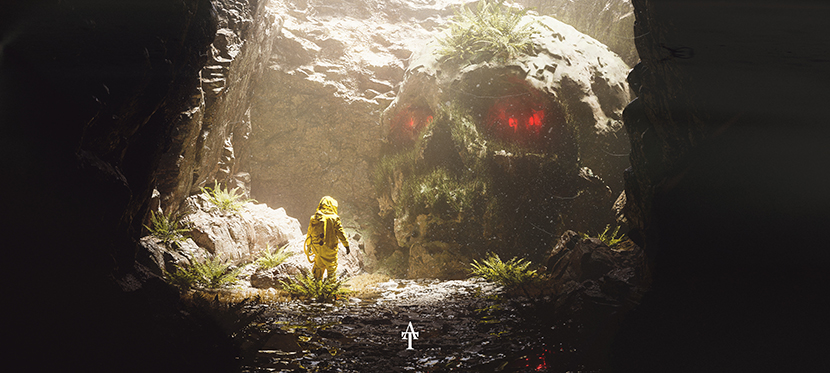
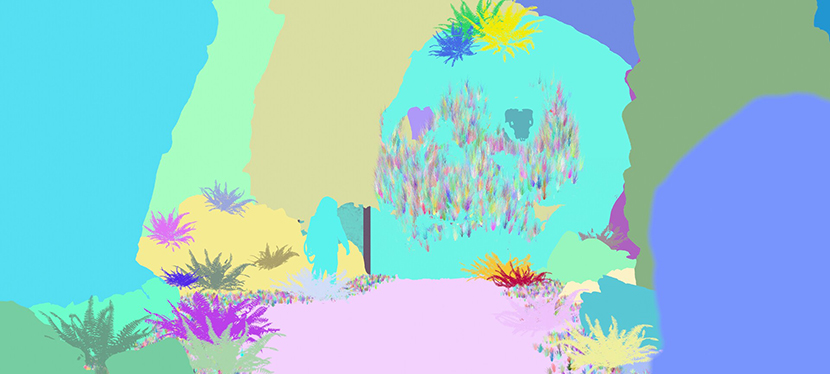 The cryptomatte below shows the simple yet effective composition of the 'Skull Cave'.
The cryptomatte below shows the simple yet effective composition of the 'Skull Cave'.
Let us talk about some of your work in more detail, starting with the ‘Skull Cave', an eerie landscape study inspired by a scene by Jack McKelvie. Can you first describe the circumstances that lead to the creation of this project and tell us what attracted you to McKelvie's original work?
I remember watching ‘Kong: Skull Island' and being amazed by the visuals, the environment, and the ambience. I felt inspired to make a scene with a similar theme, so I started imagining a radioactive environment in which Kong might have lived a long time ago, and that seemed like a sufficiently stimulating idea for a creative project!
While gathering reference material, I stumbled upon Jack's wonderful piece, which even though differed greatly from what I had in mind in terms of setting and environment, had the exact composition I was looking for. I actually recognized Jack from his videos on the Quixel YouTube channel, and I also remembered I was already friends with him on Facebook. Show him some love, he is a really cool dude!
What were your main goals for this project? Did you approach it as a technical exercise or was it more about the creative expression?
This project was both a study and a passion project. At the time, I was entirely preoccupied with my studies and facing multiple deadlines, so I knew I only had a very limited time window to finish the project. With that in mind I started with an old skull model I had sculpted in ZBrush, took it over to Blender, and made a landscape place holder. I then exported everything to 3ds max and worked on the lighting. To save time, I used quite a few Quixel Megascans assets, but I also explored tyFlow to merge the skull into the cliff. One funny thing I tried was adding the ferns to the upper part of the skull as "hair".
What were some of the challenges you had to overcome and how long did it take you to complete the project?
Finding a proper character was challenging. I initially tried a model from Sketchfab, however it was extremely low poly and ultimately unusable, so I ended up using it as a reference and made the entire suit from scratch. Thanks to the cloth simulation brush in Blender and a couple of custom-made fabric brushes I already had, this process was surprisingly fast. In fact, it was mostly just a simple model with secondary details sculpted on top, and a very simple material applied to it.
All in all, the project was made quickly using basic tools, as I focused more on the overall feel than on realism to make the scene stand out. It took me around eight hours, most of which were spent on the suit.
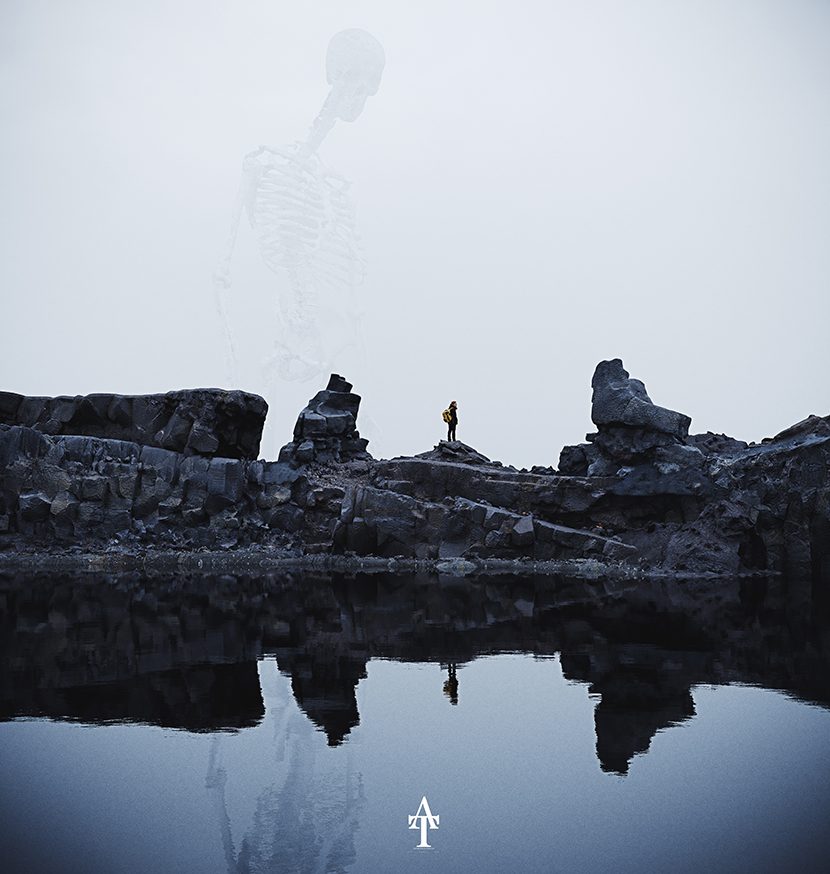 An early example of Abderrahman's environmental work, the ‘Wanderer' is being watched by a bony apparition.
An early example of Abderrahman's environmental work, the ‘Wanderer' is being watched by a bony apparition.
Another project you submitted to our campaign, ‘Wanderer', features a similar composition: a lonely human figure amidst a sublime environment. Please talk to us a bit about this scene!
This is one of my oldest projects and the first that attracted some attention, as it was featured on the VWArtclub gallery. ‘Wanderer' was inspired by a beautiful shot in the movie ‘The Deer Hunter' that sees Robert De Niro walking a similar landscape. My main goal was to make a serene, yet at the same time desolated environment. To highlight this sense of loneliness, I added the skeleton and its reflection in the water.
Compared to the more conventional archviz work of your studio, your personal portfolio encompasses a wider range of renders, both in terms of style and subject matter. How important are personal projects to you in general? What purpose do they serve for you as a 3D artist?
Personal projects are extremely important, as this is where real growth happens; it's where I can try different workflows, ideas, and techniques. With a commercial project, the responsibility I have towards a client doesn't allow for that level of experimenting; on the contrary, I have to rely on tried and tested workflows for the sake of efficiency.
Do projects like these positively affect your commercial work? How much do skill sets from something like ‘Skull Cave' translate to a bedroom interior?
If you ignore pay for a moment, the only difference between a commercial and a personal project is that I am following somebody else's vision instead of my own. I still consider the project mine and give it the same attention I give to personal studies and portfolio pieces.
The single biggest difference I can think of is how much liberty I take in enhancing realism in my personal projects by adding dirt and grime, leaks, and similar minor imperfections. In my experience, clients usually don't care about realism to that extent, what they are looking for is a solid visual representation of their idea, something reliable to build upon.
To answer the second part of the question: something like this cave scene serves as useful practice for exterior shots, playing with volumetrics, and lighting, which benefits my interior work as well.
How do you find (and manage) the time for personal projects?
To be fair, most of my personal projects in the past were made during a time when I was studying full time. However, I do still try to make time for commercial and personal projects, which is a lot easier working freelance, since I have full control over the entire pipeline.
In fact, I practice a proper filmlike pipeline, ranging from concepts design, modeling, and sculpting, to retopo, UV, all the way up to final rendering and post processing. However, there is only so much I can learn by myself, which is why I think working with a larger team would be very beneficial for me.
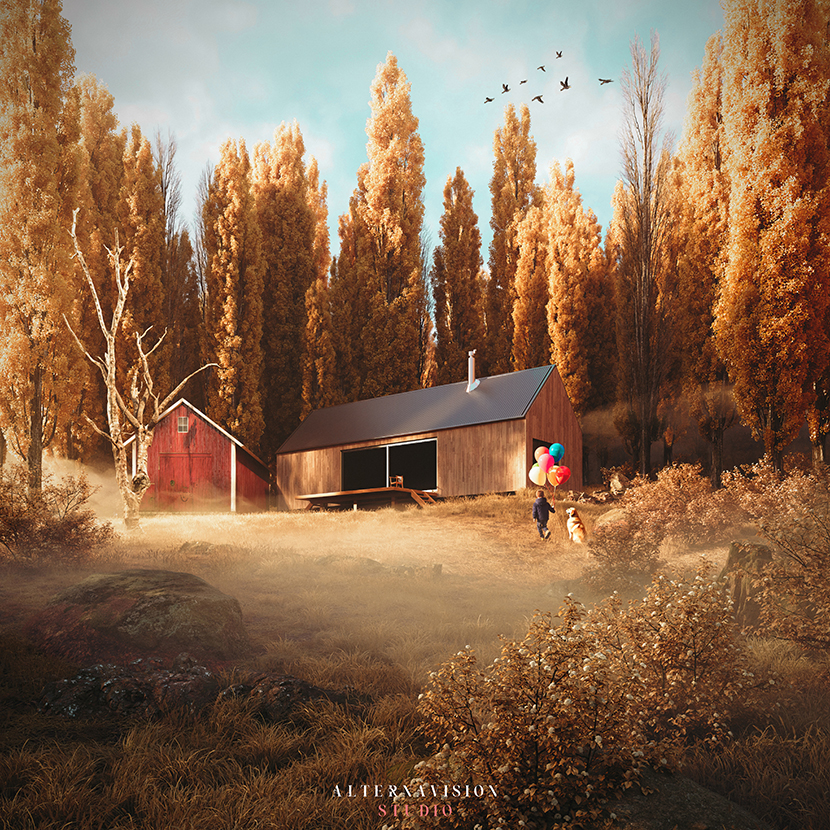 Feels like autumn: emphasizing ambiance over realism is a common theme in Abderrahman's environmental work.
Feels like autumn: emphasizing ambiance over realism is a common theme in Abderrahman's environmental work.
What software do you usually use? Are there any plug-ins or tools you would recommend?
Software is mostly a matter of personal preference, as all of them pretty much do the same thing. If anything, I find what matters more is which render engine you use.
That said, I like Blender for modeling, it is hands down the fastest and most versatile tool I've ever used, perfect to make quick art and even final productions. For final renderings, I prefer 3ds Max and Corona Renderer. Most of my images are made on a Ryzen 7 laptop with no dedicated GPU, and I found 3ds Max and Corona to offer the stability that allows for high-quality renders without too much trouble, and oddly enough, no crashes.
As a quick aside, I found most crashes in 3ds Max happen due to the auto backup interfering with your commands, so if you face too many crashes, try disabling this option – just make sure to save frequently.
Speedtree is another great tool, I like to think of it as GrowFX on steroids. If you are serious about making furniture, Marvelous Designer is the only way to go, as going through Houdini for a simple puff is just madness. ZBrush is great as well, though it might be overkill if you are not into sculpting characters, especially since blender has great sculpting tools. Finally, for post processing, Affinity Photo is my tool of choice. I did try DaVinci Resolve, but I did not get the opportunity to leverage it yet.
What is some advice you would give to aspiring CG artists?
My biggest advice would be to not fall victim to procrastination, to focus on learning the fundamentals instead of getting too hung up on specific software or tools, and to enjoy the whole process. Participate in challenges, try different approaches, and ask others, but most importantly, learn how to use google well. If you follow a structured learning curve of a proper workflow, you will soon see improvements.
Another thing I can't stress enough is the importance of references! You think you know something by heart, but believe me, you don't. Break down your reference to sections based on scale, texture, and shapes, using the 60-30-10 rule. Don't make your design too crowded, which a very common mistake I was prone to and still am at times.
Despite people often saying otherwise, I personally think it doesn't hurt to compare yourself to others occasionally. Not to belittle yourself, of course, but to track your progress and identify room for improvement. Ask yourself: what is it that makes the project of another artist stand out? Is it the lighting? The modeling? This will help you a lot.
Have you used RebusFarm before? If so, please tell us about your experience: is there anything you especially like about our service?
I tried out several large-scale render farms in the past – some even reached out to me – and I can definitely say RebusFarm is my favorite! It is very reliable and integrates perfectly with 3ds Max. With other render farms, I faced problems like vegetation not rendering properly, settings randomly changing, and, most egregiously, very unreliable cost calculations. I am happy to report that I never encountered any such issues when using RebusFarm.
In fact, we used your service not too long ago to render some aerial shots for a collaborative archviz project, and the images came out perfectly! I highly recommend it and will continue to use it frequently, especially if the Unreal Engine 5 path tracer will be supported in the future!
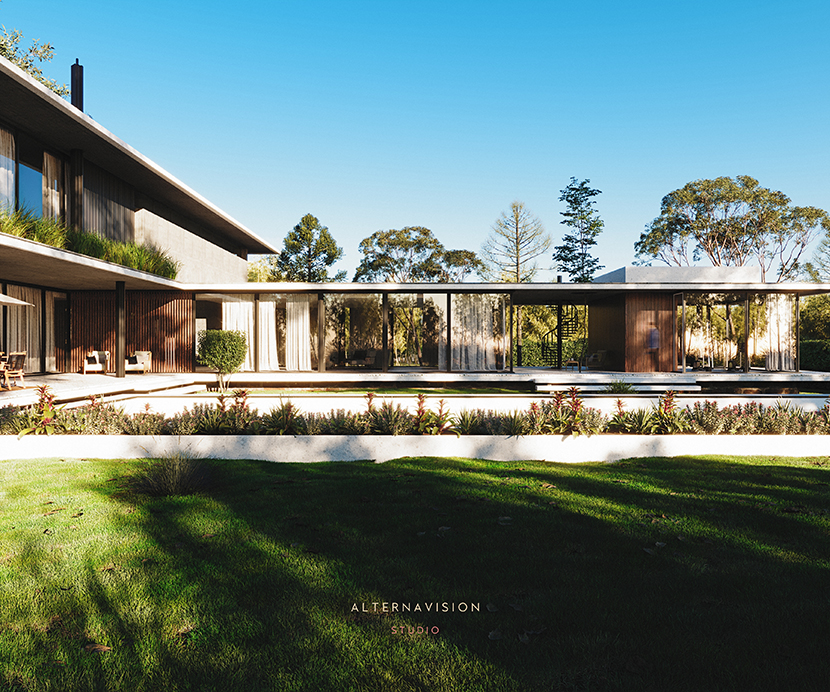 Practice makes perfect: what started as a simple recreation of the famous GG house landed Abdelrahman some of his best clients to date.
Practice makes perfect: what started as a simple recreation of the famous GG house landed Abdelrahman some of his best clients to date.
In closing, is there anything else you want to say? Any plugs, shoutouts or present or upcoming projects you would like to mention?
First and foremost, I would like to thank you for highlighting my work, I'm extremely honored and grateful for being chosen as your Artist of the Month. I would also like to announce that I will be making free project-based tutorials on my newly setup YouTube channel. As far as future projects are concerned, I am currently working on something exciting with a high-end car company, so please stay tuned for that!
Finally, if you have any feedback, questions, or are looking to share criticism or advice, feel free to shoot me a message on Instagram any time.
Abderrahman, thank you so much for taking the time and all the best in the future.
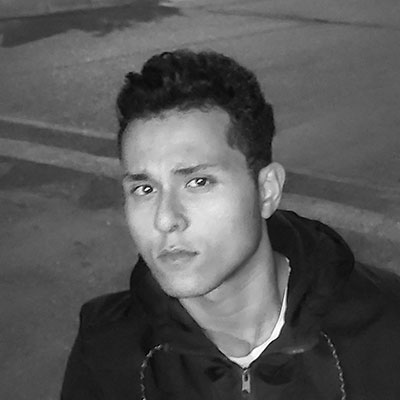
About the artist
AlternaVision Studio is a high-end architectural visualization agency, dedicated to bringing designs to life through photorealistic 3D renderings, animations, and virtual reality experiences. Founder and up-and-coming CGI generalist Abderrahman Alterkawi is tirelessly working on expanding the company's portfolio, including plans for comprehensive courses and personalized trainings.
